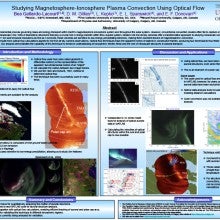Studying Magnetosphere-Ionosphere Plasma Convection Using Optical Flow
Bea
Gallardo-Lacourt
NASA/CUA
Megan Gillies, Mount Royal University
Larry Kepko, NASA
Emma Spanswick, University of Calgary
Eric Donovan, University of Calgary
Larry Kepko, NASA
Emma Spanswick, University of Calgary
Eric Donovan, University of Calgary
Poster
Plasma convection is a fundamental process governing mass and energy transport within Earth's magnetosphere-ionosphere system and throughout the solar system. However, conventional convection models often fail to capture or underestimate the contributions of dynamic mesoscale (10s–100s of kilometers) structures that play a crucial role in energy transfer within this coupled system. Modern red-line all-sky cameras offer a transformative approach to studying mesoscale convection. With spatial resolutions on the order of 1 km and temporal resolutions as fine as 3 seconds, these cameras are sensitive to low-energy precipitating electrons, making them excellent tracers of magnetospheric convection.
This work presents initial results from optical flow calculations applied to red-line all-sky camera observations. Optical flow techniques track the apparent motion of objects in consecutive frames, producing two-dimensional flow fields that reveal the dynamics of ionospheric convection. Our analysis demonstrates the capability of this technique to enhance understanding of ionospheric electric fields and the role of mesoscale structures in plasma transport.
This work presents initial results from optical flow calculations applied to red-line all-sky camera observations. Optical flow techniques track the apparent motion of objects in consecutive frames, producing two-dimensional flow fields that reveal the dynamics of ionospheric convection. Our analysis demonstrates the capability of this technique to enhance understanding of ionospheric electric fields and the role of mesoscale structures in plasma transport.

Poster PDF
Meeting homepage